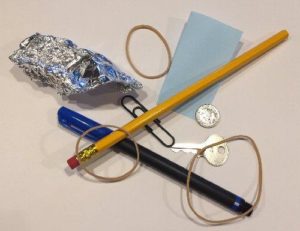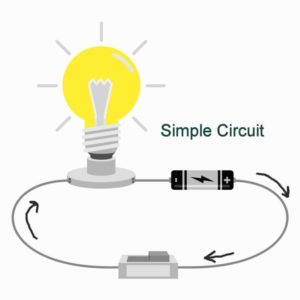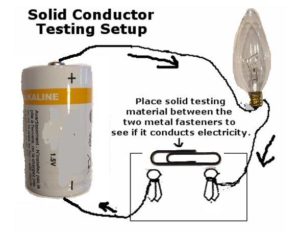Insulators and Conductors
This lesson encourages students to test different classroom materials to determine if they are conductors or insulators of electricity. Students work in teams testing their predictions about each material, then groups compare results and discuss findings.
- Learn about the electrical properties of different materials.
- Learn how conductors and insulators react to electric current.
- Solve simple algebraic manipulations involving squares and square roots.
- Learn to make predictions and draw conclusions.
- Learn about teamwork and working in groups.
Age Levels: 8-11
Build Materials (For each team)
Required Materials
- 3 Pieces of insulated wire (strip the ends)
- Size D battery
- 1.5 volt bulb and socket
- Paper fasteners
Conductors and Insulators (each team selects 5 items)
- Small pieces of metal (spoons work well)
- Small pieces of wood (craft/popsicle sticks work well)
- Paper clips
- Chalk
- Pieces of paper
- Rubber erasers
- Aluminum foil
- Metal pens
- Rubber bands
- Wood pencils
- Coins
- Hair clips
- Keys
Materials
- Conductivity tester
- Testing items
Process
Teams use their conductivity tester to test each of their selected items by placing the item between the two metal fasteners. If the bulb lights up, the item conducts electricity. If the bulb does not light up, the item does not conduct electricity. Teams should document which items are conductors and which are insulators on their worksheets.
Design Challenge
You are a team of engineers given the challenge of building a conductivity tester out of a battery, 3 pieces of wire and a bulb. Then, you will test 10 items to confirm if they are conductors or insulators.
Criteria
- Select 5 items you think are conductors and 5 items you think are insulators.
Constraints
Use only the materials provided.
- Break class into teams of 3-4.
- Hand out the Insulators and Conductors worksheet, as well as some sheets of paper for sketching designs.
- Discuss the topics in the Background Concepts Section. Instruct students to pay close attention to the Solid Conductor Testing Set Up. Set up a model conductivity tester, using wires, bulbs, and a battery. Demonstrate the properties of insulation and conductivity by testing several different materials.
- Review the Engineering Design Process, Design Challenge, Criteria, Constraints and Materials. Consider asking students how a light bulb works.
- Provide each team with their materials.
- Explain that students must assemble their own conductivity tester with a battery, 3 wires and a bulb. Each team will work together to select five materials they think will conduct electricity and five materials they think will not conduct electricity. Each team should write the items down on their worksheet.
- Announce the amount of time they have to design and build (1 hour recommended).
- Use a timer or an on-line stopwatch (count down feature) to ensure you keep on time. (www.online-stopwatch.com/full-screen-stopwatch). Give students regular “time checks” so they stay on task. If they are struggling, ask questions that will lead them to a solution quicker.
- Students meet and develop a plan for their conductivity tester. They should sketch their design.
- Teams build their designs .
- Teams use their conductivity tester to test each of their selected items by placing the item between the two metal fasteners. If the bulb lights up, the item conducts electricity. If the bulb does not light up, the item does not conduct electricity.
- Teams should document which items are conductors and which are insulators on their worksheets.
- As a class, discuss the student reflection questions.
- For more content on the topic, see the “Digging Deeper” section.
Student Reflection (engineering notebook)
- What percentage of Team One’s predictions were correct?
- Why would civil engineers, or other designing a structure, have to be very familiar with insulators and conductors.
Time Modification
The lesson can be done in as little as 1 class period for older students. However, to help students from feeling rushed and to ensure student success (especially for younger students), split the lesson into two periods giving students more time to brainstorm, test ideas and finalize their design. Conduct the testing and debrief in the next class period.
What Are Conductors and Insulators?

Conductors/Conductivity
Conductivity is the ability or power to conduct or transmit heat, electricity, or sound. Conductors are materials that electricity easily passes through, that do not resist the flow of electricity. Examples are copper, aluminum, steel, silver, gold, electrolytes. Not all materials conduct electricity equally well. Insulators Insulators are materials that resist the flow of electricity, so electricity does not easily pass through. Examples are plastic, wood, rubber, cloth, air, glass. Some materials are better electricity insulators than others.
Do you think the following items are more likely conductors or insulators? Eraser, Metal Pen, Paper Envelope, Pencil, Paper Clip, Chalk, Coin, Spoon, Nail.
What is a Simple Circuit?
Simple Circuit
A simple circuit consists of three minimum elements that are required to complete a functioning electric circuit: a source of electricity (battery), a path or conductor on which electricity flows (wire) and an electrical resistor (lamp) which is any device that requires electricity to operate. The illustration below shows a simple circuit containing, one battery, two wires, a switch, and a bulb. The flow of electricity is from the high potential (+) terminal of the battery through the bulb (lighting it up), and back to the negative (-) terminal, in a continual flow when the switch is in the on position, so current can flow.
Schematic Diagram of a Simple Circuit
The following is a schematic diagram of the simple circuit showing the electronic symbols for the battery, switch, and bulb.

Solid Conductor Testing Set Up Image

- Circuit: A complete path around which electricity can flow.
- Conductivity: The ability or power to conduct or transmit heat, electricity, or sound.
- Conductor: Material that electricity easily passes through, that do not resist the flow of electricity.
- Constraints: Limitations with material, time, size of team, etc.
- Criteria: Conditions that the design must satisfy like its overall size, etc.
- Current: The flow of electricity.
- Engineers: Inventors and problem-solvers of the world. Twenty-five major specialties are recognized in engineering (see infographic).
- Engineering Design Process: Process engineers use to solve problems.
- Engineering Habits of Mind (EHM): Six unique ways that engineers think.
- Insulator: Material that resists the flow of electricity, so electricity does not easily pass through.
- Iteration: Test & redesign is one iteration. Repeat (multiple iterations).
- Prediction: Act of saying what will or might happen in the future.
- Prototype: A working model of the solution to be tested.
Recommended Reading
- DK Eyewitness Series: Electricity (ISBN: 0751361321)
- Make Cool Gadgets for Your Room by Amy Pinchuk and Teco Rodriques (ISBN: 1894379128)
- My World of Science: Conductors and Insulators by Angela Royston (Heinemann Educational Books, ISBN: 0431137269)
Writing Activity
Write an essay (or paragraph depending on age) describing a product which would not operate well if alternate materials were used in its construction. For example, a light bulb built with a plastic thread for a filament would not operate.
Alignment to Curriculum Frameworks
Note: Lesson plans in this series are aligned to one or more of the following sets of standards:
- U.S. Science Education Standards (http://www.nap.edu/catalog.php?record_id=4962)
- U.S. Next Generation Science Standards (http://www.nextgenscience.org/)
- International Technology Education Association’s Standards for Technological Literacy (http://www.iteea.org/TAA/PDFs/xstnd.pdf)
- U.S. National Council of Teachers of Mathematics’ Principles and Standards for School Mathematics (http://www.nctm.org/standards/content.aspx?id=16909)
- U.S. Common Core State Standards for Mathematics (http://www.corestandards.org/Math)
- Computer Science Teachers Association K-12 Computer Science Standards (http://csta.acm.org/Curriculum/sub/K12Standards.html)
National Science Education Standards Grades K-4 (ages 4 – 9)
CONTENT STANDARD A: Science as Inquiry
As a result of activities, all students should develop
- Abilities necessary to do scientific inquiry
- Understanding about scientific inquiry
CONTENT STANDARD B: Physical Science
As a result of the activities, all students should develop an understanding of
- Light, heat, electricity, and magnetism
CONTENT STANDARD E: Science and Technology
As a result of activities, all students should develop
- Understanding about science and technology
National Science Education Standards Grades 5-8 (ages 10 – 14)
CONTENT STANDARD A: Science as Inquiry
As a result of activities, all students should develop
- Abilities necessary to do scientific inquiry
- Understandings about scientific inquiry
CONTENT STANDARD B: Physical Science
As a result of their activities, all students should develop an understanding of
- Properties and changes of properties in matter
- Transfer of energy
CONTENT STANDARD E: Science and Technology
As a result of activities, all students should develop
- Understandings about science and technology
Next Generation Science Standards Grades 3-5 (Ages 8-11)
Matter and its Interactions
Students who demonstrate understanding can:
- 2-PS1-2. Analyze data obtained from testing different materials to determine which materials have the properties that are best suited for an intended purpose.
- 5-PS1-3. Make observations and measurements to identify materials based on their properties
Standards for Technological Literacy – All Ages
Design
- Standard 10: Students will develop an understanding of the role of troubleshooting, research and development, invention and innovation, and experimentation in problem solving.
Student Team One Predictions:
| Materials Team One Predicts are Conductors | Materials Team One Predicts are Insulators |
| 1 | 1 |
| 2 | 2 |
| 3 | 3 |
| 4 | 4 |
| 5 | 5 |
Student Team Two Outcomes:
Test the materials selected by team one, then list each in the appropriate box.
| Conductors | Insulators |
|
|
Questions:
1. What percentage of Team One’s predictions were correct?
2. Why would civil engineers, or other designing a structure, have to be very familiar with insulators and conductors?





 Industrial Engineering
Industrial Engineering
 Computer Engineering
Computer Engineering

















